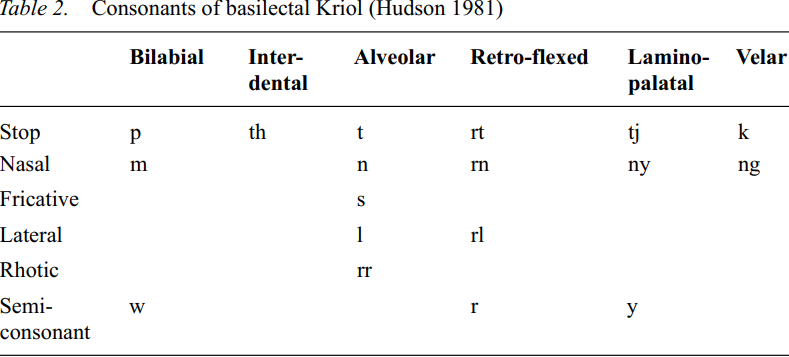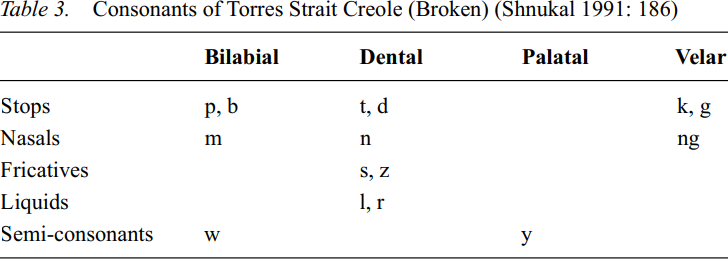


 Grammar
Grammar
 Tenses
Tenses
 Present
Present
 Past
Past
 Future
Future
 Parts Of Speech
Parts Of Speech
 Nouns
Nouns
 Verbs
Verbs
 Adverbs
Adverbs
 Adjectives
Adjectives
 Pronouns
Pronouns
 Pre Position
Pre Position
 Preposition by function
Preposition by function 
 Preposition by construction
Preposition by construction
 Conjunctions
Conjunctions
 Interjections
Interjections
 Grammar Rules
Grammar Rules
 Linguistics
Linguistics
 Semantics
Semantics
 Pragmatics
Pragmatics
 Reading Comprehension
Reading Comprehension|
Read More
Date: 2024-03-15
Date: 2024-06-13
Date: 2024-03-20
|
Australian creoles do not always recognize the voiced-voiceless consonant distinction, nor do they reliably discriminate most fricatives. Kriol varieties may incorporate a number of retroflexed and lamino-palatal consonants not found in StE. The consonants of basilectal Fitzroy Valley Kriol have been represented (using Kriol orthography) by Hudson (1981: 28) in the following table:

Torres Strait Creole (Broken) has 15 consonant phonemes, represented in Broken orthography by Shnukal as follows:

It is common for stops to substitute for fricatives and affricates. Fraser (1977) reports that in Fitzroy Crossing Children’s Pidgin the bilabial stop /p/ substitutes for /b/, /v/ and /f/ and that a dental /t/ substitutes for /ʧ/ , /ʤ/ and non-final /s/, /z/ and /Ʒ/. Similar substitutions occur in Ngukurr-Bamyili Kriol (Sandefur 1979: 37).
Although voiced and unvoiced stops both occur in Torres Strait Creole, their distribution may not be the same as in StE. Crowley and Rigsby (1979) note the replacement of a voiceless stop with a voiced one when it occurs between two vowels, as in /peba/ for ‘paper’. There is no phonemic opposition in Torres Strait Creole between [p] and [f], between [t] and [θ], between [d] and [ð] or between [b] and [v].
In Fitzroy Crossing Kriol, /d/ may alternate with /t/. Also, Sandefur (1979: 37) observes that in Kriol, /d/ may be replaced by a flapped rhotic [ř] when it occurs in a word between two vowels.
It will be observed from Table 2 that the sound represented in Kriol orthography as <th> is not the interdental fricative of StE but an interdental stop. Similarly, the retroflexed <rt> and the lamino-palatal <tj> function as stops (Hudson 1981: 28).
All the nasal consonants of StE, /m/, /n/ and /ŋ/ also occur in Australian creoles. There are, however, in basilectal Kriol additional retroflexed and palatalized nasals.
Fricatives are generally absent from basilectal Kriol though in basilectal Fitzroy valley Kriol, there is one fricative, /s/. Fricatives are reduced in occurrence in Torres Strait Creole. There is no phonemic opposition in Torres Strait Creole between [s] and [ʃ] (Crowley and Rigsby 1979; Dutton 1970). In Kriol, sibilants tend to be deleted to avoid consonant clusters (Sharpe and Sandefur 1976); in Bamyili (Barunga) the affricates /ʧ/ and /ʤ/ are replaced by a lamino-palatal stop /dj/ (Sandefur 1979: 37). The glottal fricative /h/ is generally absent from the creoles.
The lateral /l/ is common to English and most Aboriginal languages and is retained in the creoles. Basilectal Kriol also has retroflexed and palatalized laterals.
The rhotic /r/ is trilled in basilectal Kriol and Torres Strait Creole. It may also be flapped when it occurs between two vowels (Sandefur 1979: 37).
|
|
|
|
الصين.. طريقة لمنع تطور قصر النظر لدى تلاميذ المدارس
|
|
|
|
|
|
|
ماذا سيحدث خلال كسوف الشمس يوم السبت؟
|
|
|
|
|
|
|
قسم الشؤون الدينية يختتم محاضراته الرمضانية في صحن مرقد أبي الفضل العباس (عليه السلام)
|
|
|